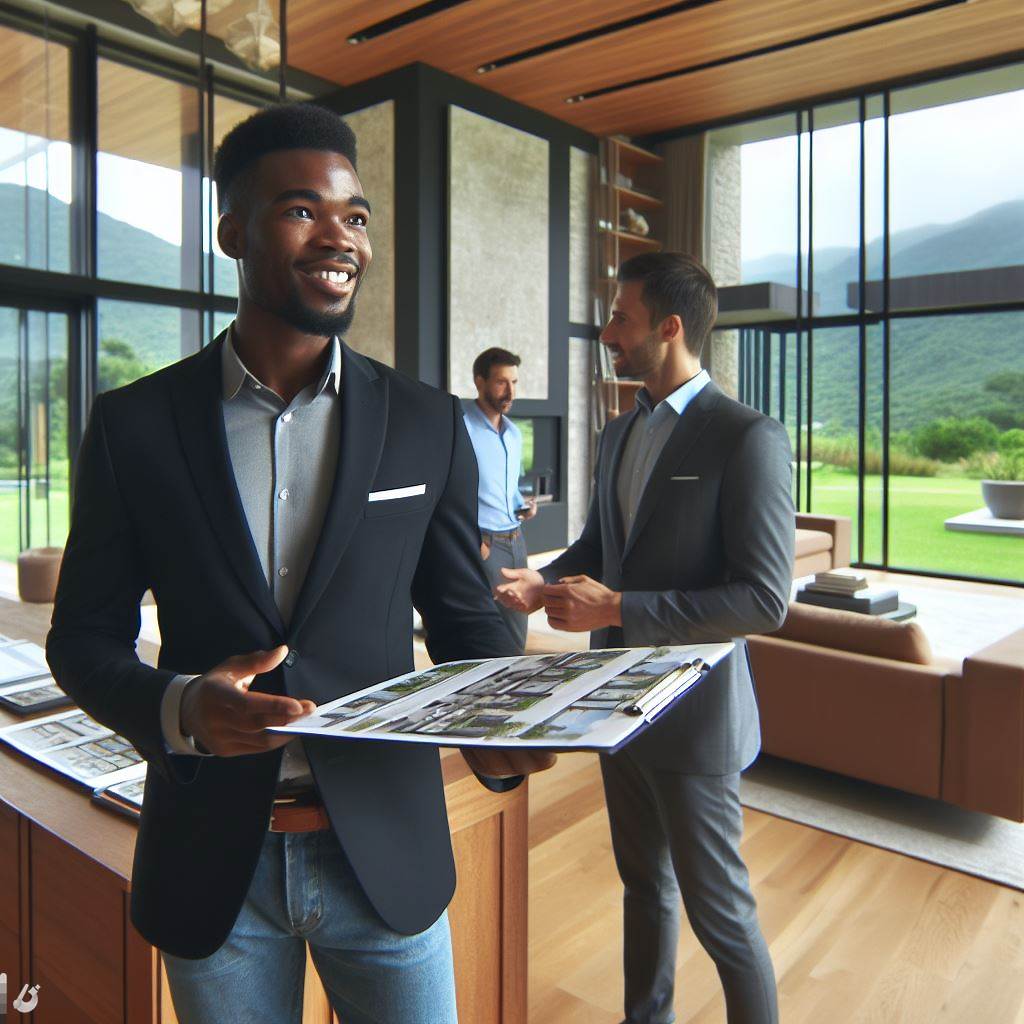Introduction
In interior design, texture refers to the tactile quality of surfaces, materials, and finishes used in a space.
It adds depth and visual interest to a room, creating a dynamic and inviting atmosphere.
Texture is an essential element in high-end interior designs, as it plays a crucial role in creating a visually appealing space.
It adds sophistication, elegance, and luxury to the overall design.
In high-end interior designs, the focus on texture is emphasized to create a rich and layered look.
By incorporating a variety of textures, such as smooth, rough, glossy, or matte, designers can achieve a sense of balance and harmony in the space.
The use of texture in high-end interior designs extends beyond just the choice of materials and finishes.
It can also be created through the use of textiles, furniture, accessories, and lighting.
Each element adds its own unique texture, contributing to the overall aesthetic.
Texture also has the power to influence how a space is perceived.
By strategically incorporating different textures, designers can create visual focal points, draw attention to specific areas, or even make a room appear larger or smaller.
In fact, texture is a vital component in high-end interior designs.
It adds depth, visual interest, and luxuriousness to a space, creating a visually appealing and inviting environment.
By paying attention to the textures used in a room, designers can elevate the overall design and create a truly high-end interior.
Understanding Texture
In the realm of high-end interior design, texture serves as the silent maestro orchestrating a symphony of visual and tactile experiences.
Transform Your Real Estate Decisions
Unlock personalized real estate insights crafted just for you. Get actionable advice designed to amplify your success.
Get StartedTo embark on a journey of texture play, one must first delve into the fundamental understanding of this intricate design element.
Differentiating Textures from Colors and Patterns
Texture, often overshadowed by the flamboyance of colors and patterns, is the unsung hero of interior design.
While colors and patterns capture attention, textures invite touch and elevate the sensory experience.
Understanding the distinction is key – colors evoke emotions, patterns create visual interest, and textures provide depth and richness.
They are the nuances that transform a space from ordinary to extraordinary.
The Tactile and Visual Elements of Texture
Texture operates on two levels – tactile and visual.
Tactile texture is the physical surface quality that can be felt by touch, while visual texture is the illusion of texture created through patterns and colors.
High-end interior designs seamlessly blend both aspects, inviting inhabitants to not only see but also feel the essence of the space.
A plush velvet sofa or a rough-hewn stone wall not only catches the eye but beckons to be explored through touch.
Types of Textures Commonly Used in Interior Design
The palette of textures available to designers is vast and diverse.
From the smooth elegance of polished marble to the warmth of natural wood, each texture contributes to the overall narrative of a space.
Commonly used textures include the tactile allure of shaggy rugs, the smoothness of glass surfaces, and the rustic charm of reclaimed wood.
The juxtaposition of these textures creates a tapestry of sensory delight, turning a room into an immersive experience.
In the grand tapestry of high-end interior design, texture stands as the masterstroke, infusing spaces with a richness that transcends the visual.
Showcase Your Real Estate Business
Publish your company profile on our blog for just $200. Gain instant exposure and connect with a dedicated audience of real estate professionals and enthusiasts.
Publish Your ProfileAs we explore the myriad textures at our disposal, we unravel the intricate layers that transform a house into a luxurious haven.
Stay tuned for the next section as we delve into the art of incorporating textures seamlessly into your interior design masterpiece.
Read: High-End Market: Houston’s Latest Landscape
Incorporating Texture in High-End Interior Designs
Texture in interior design is a powerful tool to create visual interest and add depth to a space.
High-end interior designs often incorporate various textures to bring a luxurious and sophisticated feel.
In this section, we will explore different ways to incorporate texture in high-end interior designs.
Creating texture through materials
One way to introduce texture is by using materials such as stone, wood, and metals.
These natural materials not only add texture but also bring a sense of warmth and richness to the space.
For example, a stone accent wall can add a rugged texture and create a focal point in a high-end living room.
The use of textured wall coverings
Textured wall coverings, such as wallpapers and plaster finishes, are another way to incorporate texture in high-end interior designs.
Wallpaper with embossed patterns or metallic accents can add a luxurious touch to the walls.
Plaster finishes, like Venetian plaster, create a textured effect that enhances the overall aesthetic.
Textured fabrics and upholstery
Textured fabrics and upholstery play a crucial role in high-end interior designs.
Velvet, for instance, adds a sumptuous texture and elevates the elegance of furniture pieces.
Similarly, textured upholstery fabrics like jacquard or chenille bring depth and dimension to sofas and chairs, creating a visually appealing environment.
The role of textured rugs and carpets
Textured rugs and carpets not only provide comfort underfoot but also contribute to the overall texture play in high-end interior designs.
Natural fiber rugs, such as jute or sisal, add a textural element while maintaining a luxurious look.
Additionally, patterned or plush carpets can enhance the overall visual appeal of a space.
In essence, texture is a vital component in high-end interior designs.
By incorporating materials like stone, wood, and metals, using textured wall coverings, introducing textured fabrics and upholstery, and adding textured rugs and carpets, designers can create a visually striking and sophisticated space.
Texture adds depth, richness, and visual interest, enhancing the overall luxurious ambiance.
Read: Luxury Spaces: Bold Geometric Patterns

Mixing and Matching Textures
When it comes to high-end interior designs, creating a visually appealing space involves more than just choosing the right furniture or color palette.
Texture play is a crucial element that can elevate the overall look and feel of a room.
By mixing and matching textures, you can bring depth, interest, and sophistication to your interior design.
Here are some essential points to consider when it comes to incorporating texture into your high-end interior designs:
The importance of balance and contrast
One of the key factors to keep in mind when mixing and matching textures is the importance of balance and contrast.
A room filled with solely smooth surfaces can feel monotonous and lack visual interest.
On the other hand, an excessive mix of clashing textures can result in a chaotic and overwhelming space.
Achieving the right balance is crucial to create a harmonious and visually appealing design.
Showcase Your Real Estate Business
Publish your company profile on our blog for just $200. Gain instant exposure and connect with a dedicated audience of real estate professionals and enthusiasts.
Publish Your ProfilePay attention to the weight and scale of each texture and ensure they complement each other.
Additionally, contrasting textures can add depth and dimension to a room.
For example, pairing a rough, textured wall with a smooth velvet sofa creates an intriguing contrast that captivates the eye.
By carefully selecting complementary textures that balance and contrast each other, you can achieve a more dynamic and engaging interior design.
Tips for selecting complementary textures
Choosing complementary textures involves careful consideration and thought.
Here are a few tips to help you select textures that work well together:
- Consider the overall style and theme of your design. Different textures suit different aesthetics, whether it’s rustic, contemporary, or minimalist.
- Think about the function of the space. For example, a cozy living room might benefit from plush, soft textures, while a kitchen could incorporate sleek, glossy surfaces.
- Mix organic and synthetic textures for variety. Combining natural elements like wood, stone, or woven fabrics with man-made materials such as glass or metal can create a visually interesting contrast.
- Experiment with different tactile qualities. Play with textures that have varying levels of roughness, smoothness, softness, or hardness to add depth and sensory appeal.
The use of multiple textures in different areas of the room
Another way to incorporate texture play in high-end interior designs is by using different textures in various areas of the room.
This approach helps define zones, adds visual interest, and enhances the overall ambiance. Consider incorporating textures in the following areas:
- Wall treatments: Experiment with textured wallpapers, geometric tiles, or textured paneling to create a stunning focal point.
- Furniture: Opt for upholstery with interesting patterns or textures, such as velvet, silk, or leather, to add luxury and sophistication.
- Accessories: Introduce various textures through throw pillows, rugs, curtains, and decorative objects to add layers of visual interest.
- Flooring: Explore options like hardwood, tiles, or rugs with varying textures and patterns to anchor the room and create depth.
By thoughtfully incorporating a range of textures in your high-end interior designs, you can transform a space into a captivating and visually appealing environment.
Remember to find balance and contrast, select complementary textures, and experiment with different areas of the room to create a truly unique and luxurious design.
Read: The Evolution of Dallas’s Upscale Properties
Creating Visual Interest with Texture
Texture is a crucial element in high-end interior designs as it has a significant impact on the overall aesthetic.
When used effectively, texture play can add depth and richness to a space, creating a visually intriguing environment.
Here, we will discuss the importance of texture and showcase examples of high-end designs that effectively use texture play.
Impact of Texture on the Overall Aesthetic
Texture is the tactile quality of a surface, and it plays a vital role in interior design.
It adds dimension, interest, and character to a space, elevating its overall aesthetic.
Texture can create a sense of luxury, sophistication, or warmth, depending on the intended ambiance.
Examples of High-End Designs
- Marble and Velvet: In high-end designs, marble surfaces and velvet upholstery are often paired to create a luxurious and glamorous texture play. The smoothness of marble combined with the softness of velvet adds a touch of elegance to the space.
- Natural Fibers and Metal: Combining natural fibers such as jute or rattan with metallic finishes like brass or gold creates an intriguing contrast. The organic texture of natural fibers against the sleekness of metal brings a contemporary and sophisticated feel to the design.
- Textured Wallcoverings: Wallcoverings with raised patterns or embossed textures are popular in high-end designs. These visually interesting surfaces add depth and visual appeal to walls, transforming them into focal points of the space.
Tips for Layering Textures
- Select a focal point: Choose one element or area in the room to highlight with texture, such as a textured wall, a statement piece of furniture, or a unique artwork. This will create a visual anchor for the design.
- Mix and match: Experiment with combining different textures to add interest. Pair smooth surfaces with rough ones, shiny finishes with matte ones, and soft fabrics with hard materials. The contrasting textures will create a dynamic and visually engaging space.
- Consider scale: Play with different scales of textures to achieve a balanced and harmonious look. Mix larger patterns with smaller ones, chunky textures with delicate ones. This will help create a sense of depth and variety in the design.
- Layer textiles: Use a variety of textiles, such as rugs, throws, pillows, and curtains, to add layers of texture. Mixing different fabrics like velvet, silk, or wool will further enhance the richness and depth of the space.
- Lighting effects: Proper lighting can accentuate the textures in a room. Use spotlights or ambient lighting to highlight textured surfaces, casting shadows that emphasize the depth and dimension of the space.
All in all, texture play is an essential aspect of high-end interior designs.
By effectively incorporating different textures into a space, designers can create visually intriguing environments that exude luxury and sophistication.
From marble and velvet to natural fibers and metallic finishes, the possibilities for texture combinations are endless.
By following the tips mentioned above, designers can layer textures in a way that adds depth and richness to the overall aesthetic, resulting in a visually captivating space.
Read: Austin’s Top-Tier Real Estate: A Deep Dive
Maintaining a Cohesive Design
In high-end interior designs, maintaining a cohesive design is crucial for creating a visually pleasing and harmonious space. Here are some important considerations:
Ensuring the textures chosen align with the overall design theme
- Identify the design theme and select textures that complement it, whether it’s modern, rustic, sleek, or eclectic.
- Coordinate textures across different elements such as furniture, walls, flooring, and accessories to create a cohesive look.
Avoiding overwhelming the space with too many competing textures
- Limit the number of textures used to maintain a balanced and visually appealing design.
- Choose a dominant texture and complement it with a few secondary textures for depth and interest.
- Consider the scale and proportion of textures to ensure they harmonize with each other.
Strategies for incorporating texture without sacrificing functionality
- Opt for textured fabrics or wallpapers in high-use areas where durability is essential.
- Introduce texture through accessories such as pillows, throws, or rugs, which can be easily replaced or changed.
- Experiment with different materials such as wood, metal, glass, or stone to add tactile interest.
- Include textured elements in unexpected places, like textured ceilings or textured backsplashes in the kitchen.
By carefully considering these strategies, you can successfully incorporate texture into your high-end interior design while maintaining functionality and aesthetics.
A cohesive and well-designed space will create a luxurious atmosphere that is both visually pleasing and functional.
Conclusion
To recap, texture plays a vital role in high-end interior designs.
It adds depth, visual interest, and a luxurious touch to any space.
By incorporating various textures, designers can create a multidimensional and visually appealing environment.
I encourage readers to experiment with different textures in their own spaces.
Whether it’s through textured wallpapers, plush rugs, or velvet upholstery, don’t be afraid to mix and match.
Showcase Your Real Estate Business
Publish your company profile on our blog for just $200. Gain instant exposure and connect with a dedicated audience of real estate professionals and enthusiasts.
Publish Your ProfileExplore the possibilities and unleash your creativity to achieve a unique and personalized interior design.
In the end, texture play can elevate the design aesthetic to new heights. It has the power to transform a plain and boring room into a sophisticated and elegant space.
So, don’t overlook the importance of texture in your design projects.
As a final thought, always remember that texture is not solely limited to tangible elements.
Lighting, patterns, and even colors can contribute to the overall texture of a room.
Embrace the power of texture and let it guide you in creating exceptional high-end interior designs.




